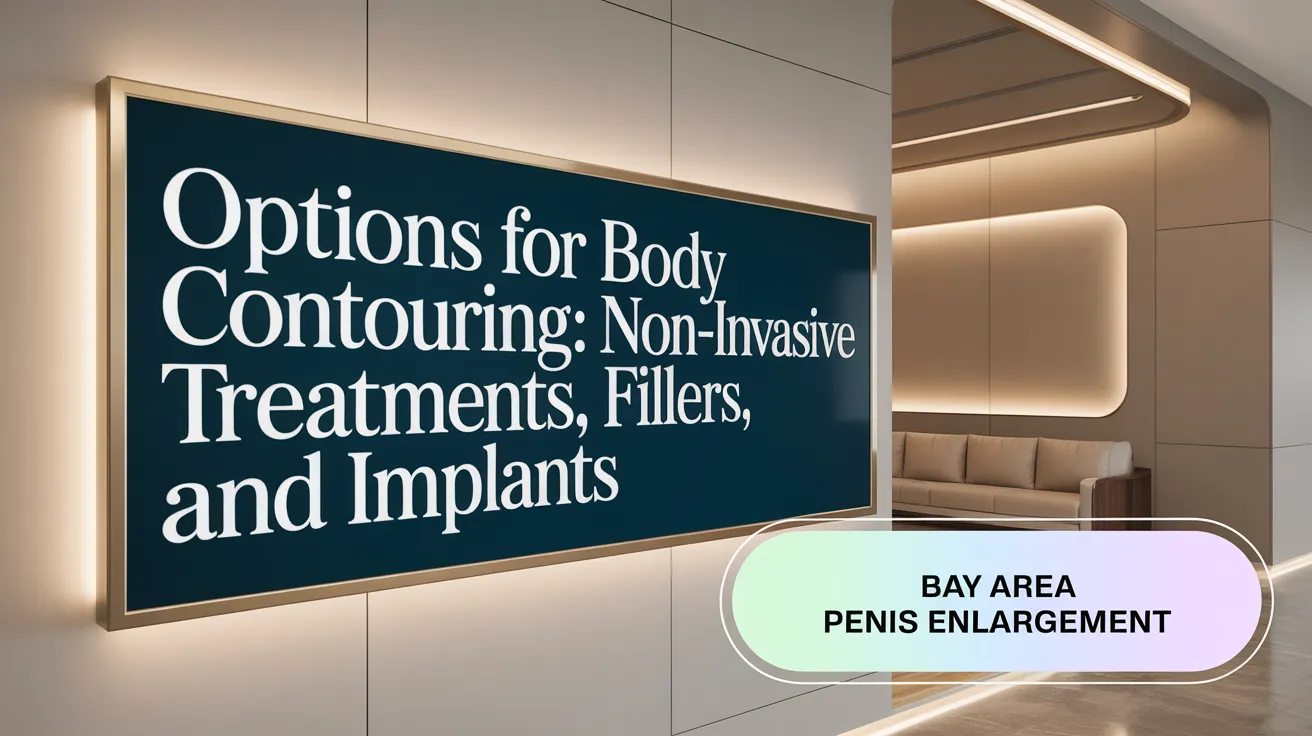Introduction to Surgical Penis Enlargement
Purpose and Scope of Surgical Penis Enlargement
Surgical penis enlargement is primarily aimed at increasing the visible size — length or girth — of the penis. This category encompasses a range of procedures designed to enhance penile appearance, improve confidence, and address medical conditions such as micropenis or buried penis, which may cause functional difficulties with urination or sexual activity.
Common Motivations for Surgery
While some patients pursue surgery for congenital or functional reasons like micropenis or a buried penis, the majority seek enlargement for aesthetic reasons linked to personal perception and body image. Psychological factors including body dysmorphic disorder or anxiety about penile size can drive the decision. It's important that candidates undergo psychological evaluation to ensure realistic expectations and suitability.
Overview of Surgical and Non-Surgical Methods
Surgical approaches include ligamentolysis (cutting the suspensory ligament) to increase apparent length, fat grafting or dermal filler injections to enhance girth, implantation of FDA-approved devices like the Penuma silicone implant for durable girth and length improvement, and removal of suprapubic fat to reveal a buried penis. Each surgical option carries specific benefits and risks, with recovery periods varying by procedure.
Non-surgical methods, such as topical creams, supplements, traction devices, weights, or testosterone therapy, are generally not effective or may carry safety risks and are not recommended without medical supervision. Injectable fillers and traction therapy offer minimally invasive options but often have limited durability or modest effectiveness.
Common Surgical Procedures for Penis Enlargement
What medical procedures are commonly used for male genital enhancement?
Male genital enhancement encompasses several surgical techniques aimed at increasing the length and/or girth of the penis, often for aesthetic or functional reasons. A key lengthening procedure is ligamentolysis, which involves cutting the suspensory ligament. This causes the penis to hang lower, thereby increasing the apparent length without altering the actual length of the erect penis.
For girth enhancement, common methods include fat transfer and dermal filler injections. Fat injections involve harvesting fat via liposuction from other parts of the body and injecting it into the penis to increase thickness. Dermal fillers—often hyaluronic acid or biostimulant fillers—are also injected to provide volume and stimulate natural collagen formation, resulting in enhanced girth with minimal downtime. These fillers are typically temporary but offer an excellent safety profile.
The Penuma® silicone implant stands out as the only FDA-cleared surgical device specifically designed for penile augmentation. This soft silicone implant is placed beneath the penile skin to increase both girth and length appearance. The procedure is minimally invasive, with a typical surgery time of about 45 minutes and generally low complication rates.
In men with a partially concealed or “buried” penis, suprapubic fat removal (lipectomy) is performed. This involves liposuction or surgical excision of the fat pad above the penis to reveal more of the shaft and improve visual length without affecting the true penile size.
Each procedure requires thorough preoperative evaluation, including health screening and psychological assessment, along with clear counseling about risks such as infection, scarring, erectile dysfunction, or dissatisfaction with results. Postoperative care varies by technique but commonly includes activity restrictions and follow-up visits to monitor healing and optimize outcomes.
These established surgical interventions, combined with promising nonsurgical injectable treatments, provide men seeking enhancement with a range of effective, safe, and personalized options tailored to their goals.
Patient Selection and Preoperative Considerations
Indications including micropenis and buried penis
Surgical penis enlargement overview is primarily indicated for men with medical conditions such as micropenis—defined as a stretched penile length (SPL) of less than 7.5 cm—or buried penis, which can cause difficulty with urination, sexual function, or hygiene. These conditions often require intervention to restore function and improve quality of life.
Psychological screening and body image considerations
Candidates seeking penis enlargement for cosmetic reasons undergo psychological evaluation before surgery to differentiate genuine anatomical needs from body dysmorphic disorder (BDD) or small penis anxiety (SPA). Such psychogenic conditions can drive unrealistic expectations and dissatisfaction. Addressing psychological health beforehand helps ensure that surgery benefits the patient’s overall wellbeing.
Comprehensive health and risk factor evaluation
Preoperative assessment for surgery includes a detailed evaluation of general health status, smoking habits, diabetes, medication use, and history of pelvic or penile surgeries. Circumcision status and potential anesthetic risks are also considered. This comprehensive workup minimizes perioperative complications and guides personalized treatment planning.
Patient education on risks and realistic expectations
Surgeons provide detailed counseling about potential risks including infection, scarring, loss of sensation, erectile dysfunction, and possibility of dissatisfaction with results. Recovery timelines vary by procedure but typically include restrictions on sexual activity for up to six weeks. Patients are informed that increases in length or girth are often modest and that non-surgical methods have limited efficacy. Emphasizing realistic goals supports patient satisfaction and safety.
What qualifications and expertise should a patient look for in a surgeon performing male genital enhancement procedures?
Patients should seek board-certified plastic or urologic surgeons with extensive experience in male genital enhancement, including penile lengthening, girth augmentation, and implantation of FDA-approved devices such as the Penuma® silicone implant. Surgeons who provide personalized care and employ minimally invasive techniques, coupled with thorough preoperative psychological and health evaluations, offer safer procedures with higher satisfaction rates. Transparency about risks, recovery, and realistic outcomes is critical. Choosing a highly qualified surgeon ensures that patients receive expert guidance and state-of-the-art treatment tailored to their individual needs.
Surgical Techniques: Lengthening Procedures

Suspensory Ligament Release to Increase Apparent Penile Length
One of the most common surgical techniques for penile lengthening is suspensory ligament release, also known as ligamentolysis procedure. This procedure involves cutting the suspensory ligament that anchors the penile shaft to the pubic bone, allowing the penis to hang lower and thus appear longer, particularly in its flaccid state. Although the actual erectile length generally remains unchanged, suspensory ligament release can result in an increased visible length ranging from 1 to 3 centimeters in the flaccid penis (Penile elongation surgery review).
V-Y Advancement Flaps and Suprapubic Lipectomy
To further enhance lengthening outcomes, suspensory ligament release is frequently combined with skin flaps, such as V-Y advancement flaps, which involve making dorsal skin incisions closed in a V to Y shape to provide additional penile shaft coverage after ligament division. Suprapubic lipectomy is another adjunct procedure, especially useful in cases of buried penis, removing excess suprapubic fat and skin to expose more of the penile shaft and improve apparent length.
Potential Benefits and Limitations of Lengthening Surgery
Lengthening procedures may benefit candidates with micropenis or buried penis by improving urinary function and facilitating sexual activity. Aesthetic improvement and enhanced self-esteem are commonly reported among men who undergo these surgeries for cosmetic reasons with realistic expectations (Realistic expectations for surgery). However, the procedures have limitations; erect penile length is usually unaffected, and gains are predominantly in flaccid length and appearance. Potential complications include scar formation, loss of ligament support leading to penile instability during erection, and possible erectile dysfunction (Risks of penis enlargement surgery.
Outcomes and Recurrence Risks
Reported satisfaction rates after suspensory ligament release surgeries vary widely, from 30% to 65% (Patient satisfaction and expectations. Recurrence of ligament support through fibrous tissue regrowth can lead to a reduction of length gains over time. Additionally, postoperative complications such as wound healing problems and penile shortening due to scarring have been documented. Therefore, thorough patient counseling and realistic expectation setting are critical before undertaking these lengthening procedures.
Surgical Techniques: Girth Enhancement Approaches

Autologous Fat Grafting and Liposuction-Based Fat Transfer
Autologous fat grafting involves harvesting fat via liposuction from areas like the abdomen or thighs and injecting it into the penile shaft to increase girth. While it can provide a natural-feeling enlargement, risks include uneven contours, fat resorption leading to reduced volume over time, lumpiness, and potential complications such as fat necrosis or embolism. Multiple sessions may be necessary to maintain desired results. For more information, see Autologous fat grafting in penile augmentation and Fat transfer procedure.
Dermal Fillers for Penile Girth Enhancement
Dermal fillers are minimally invasive alternatives using substances like hyaluronic acid (HA) and poly-L-lactic acid (PLA). HA is biocompatible and absorbable, producing significant girth increases with a good safety profile and effects lasting 18 to 30 months. PLA stimulates collagen production for longer-lasting volume, with some studies showing stable girth enhancement for up to 18 months. Temporary fillers require periodic touch-ups. Risks include swelling, bruising, and rare allergic reactions. Additional details can be found in Dermal fillers for penile enlargement and Injectable penile treatments.
Silicone-Based Implants: The Penuma® Device
The Penuma® silicone implant is the only FDA-cleared silicone device designed specifically for cosmetic penile girth enhancement. It is a soft silicone sleeve placed under penile skin during a 45-minute surgery under local or general anesthesia. Patients report an average 56.7% increase in girth with high satisfaction. However, there are risks such as infection, scarring, implant migration, and the potential need for removal or revision surgery. Learn more about the Penuma® silicone implant and FDA-cleared Penuma silicone implant.
Advantages and Risks Summary
| Method | Advantages | Risks/Disadvantages |
|---|---|---|
| Autologous Fat Grafting | Natural tissue, no foreign material | Fat absorption, irregularity, multiple treatments (Fat injection for penis enlargement |
| Dermal Fillers (HA, PLA) | Minimally invasive, well-tolerated, reversible | Temporary, requires repeat treatments (Dermal fillers usage |
| Penuma® silicone implant | Durable, FDA approved, significant girth gain | Infection, scarring, surgical risks (Risks of penis enlargement surgery |
Each method offers different balances between effectiveness, invasiveness, permanence, and risk profile. Careful patient selection, counseling on realistic outcomes, and expert surgical technique are essential to optimize safety and satisfaction. For comprehensive guidance, see Penis enlargement surgery overview.
The Penuma® Implant: An FDA-Approved Option

Description and procedure details
The Penuma® silicone implant is an FDA-cleared medical device specifically designed for penile enhancement, particularly aimed at increasing girth and improving overall penile appearance. It consists of a soft silicone sleeve placed beneath the penile skin through a single incision, typically performed under local or general anesthesia. The procedure usually takes about 45 minutes and is minimally invasive, focused on enhancing the flaccid and erect penis girth as well as some improvements in perceived length.
Safety profile and complication rates
This implant boasts a low complication rate, with national data showing about 3% incidence of surgical complications such as infection or implant-related concerns. Dr. Valenzuela, a leading urologist, reports even lower rates (under 1%) with strict surgical protocols and local nerve block anesthesia that avoids the need for narcotics. Risks include infection, scarring, implant malposition, and in rare cases, the need for removal or revision. However, the Penuma® silicone implant is considered safer and more predictable compared to traditional fat transfer or suspensory ligament division methods.
Patient satisfaction and outcomes data
Studies demonstrate an average girth increase of approximately 56.7% following Penuma implantation, with high patient satisfaction rates regarding both cosmetic and psychological benefits. Patients often report improved confidence and body image upon recovery. The device’s durability offers sustained results beyond temporary fillers or fat grafts, which can resorb over time. The fast recovery and relatively short downtime (a few weeks before resuming sexual activity) also contribute to a positive patient experience as detailed in postoperative care and recovery.
Comparison with other enhancement methods
Compared to autologous fat injections or dermal fillers, Penuma provides a more permanent and stable augmentation. Ligamentolysis procedure primarily improves flaccid length but does not actually increase erect size and carries significant risks such as erectile dysfunction. Fat grafting may cause uneven texture, absorption, and require multiple sessions. Injectable fillers like hyaluronic acid are temporary and require repeats every 18–30 months. Non-surgical options like traction devices yield modest length increases but lack consistent outcomes. Therefore, Penuma stands out as the only FDA-approved implant combining safety, effectiveness, and durability for cosmetic penile enhancement according to the American Urological Association guidelines and medical reviews.
| Aspect | Penuma Implant | Fat Transfer/Injection | Ligamentolysis | Injectable Fillers |
|---|---|---|---|---|
| Procedure Time | ~45 minutes | Variable, longer due to fat harvesting | 1–2 hours | ~30 minutes |
| Duration of Results | Long-lasting, stable | Variable; significant reabsorption | Permanent with risks | Temporary (18-30 months) |
| Risk Level | Low (3% complications) | Moderate to high (lumpiness, necrosis) | Moderate to high (functional risks) | Low to moderate (allergic reactions) |
| Patient Satisfaction | High | Moderate | Variable, often low | Variable |
| FDA Approval | Yes | No | No | No |
Risks and Complications of Penis Enlargement Surgery

Infection, Scarring, Penile Deformity, and Loss of Sensation
Penis enlargement surgery overview carries several inherent risks due to the sensitive nature of the genital tissues and complexity of the procedures. Common complications include infections at the surgical site, which require timely antibiotic treatment to prevent severe outcomes. Scarring can lead to irregularities in appearance or hinder functional aspects. Penile deformities, such as curvature or irregular shape, may arise, especially following procedures like fat grafting for penile augmentation or ligament division surgery. Additionally, patients risk a loss or alteration of penile sensation, impacting sexual pleasure.
Potential for Erectile Dysfunction and Dissatisfaction with Results
One of the most serious complications is erectile dysfunction (ED), which can occur due to nerve or vascular damage during surgery. Though some lengthening procedures make the penis appear longer, actual functional enhancement is often limited, which can lead to patient dissatisfaction. Psychological factors also play a role; realistic expectations for surgery may exacerbate disappointment despite technically successful procedures.
Specific Risks Linked to Different Procedures
Surgical lengthening through ligamentolysis poses risks of penile instability and ED. Fat injections or dermal fillers can cause lumpiness, fat reabsorption, or uneven contouring. Implantation of devices such as Penuma® silicone implant carries risks such as infection, implant malposition, or erosion. Suprapubic lipectomy aimed at revealing buried penis can also involve wound healing issues. Each method has unique risk profiles requiring careful patient selection and surgical expertise.
Importance of Realistic Expectations and Qualified Surgical Care
Comprehensive preoperative assessment including psychological evaluation before surgery is essential to ensure suitability for surgery and understanding of risks. Realistic expectations improve patient satisfaction and reduce risk of regret. Choosing a board-certified surgeon with expertise in male genital procedures is critical to minimize complications and manage outcomes effectively. Postoperative care and adherence to postoperative care guidelines further reduce adverse events.
Proper counseling helps patients make informed decisions about cosmetic versus medically indicated penile enhancement, balancing potential benefits against the inherent surgical risks.
Postoperative Care and Recovery

Pain management and infection prevention
Postoperative care following penis enlargement surgery involves careful pain control using prescribed analgesics to keep discomfort manageable. Antibiotic therapy is typically administered to prevent infection, which is a notable risk with these procedures. Patients are advised to monitor for signs of infection such as redness, swelling, or discharge and to seek prompt evaluation if these occur.
Activity restrictions including sexual abstinence
Patients are instructed to avoid strenuous physical activities for approximately 4 to 6 weeks, depending on the specific procedure performed. Sexual activity is generally restricted for up to 6 to 8 weeks to allow ample healing time and to minimize risks of injury or implant displacement. Activities that increase intra-abdominal pressure or could disrupt surgical sites should be postponed until cleared by the surgeon. Refer to postoperative care and recovery instructions for detailed guidance.
Typical recovery timelines by procedure
Recovery durations vary by procedure: ligamentolysis procedure and Penuma® silicone implant surgery often require around 6 weeks before resuming normal sexual function. Fat grafting and dermal filler injections usually have shorter downtime, with gradual normalization over a few weeks. More complex reconstructive surgeries may require extended recovery and closer monitoring as discussed in surgical penile enhancement options.
Follow-up care and monitoring for complications
Scheduled postoperative visits enable the surgeon to assess wound healing, detect early complications such as scarring, deformity, or erectile dysfunction, and ensure patient satisfaction with the results. Ongoing psychological support may be beneficial, considering many patients seek surgery based on body image perceptions (psychological evaluation before surgery. Prompt management of complications is essential for optimal outcomes and long-term penile health. For more details, see risks and complications of penis enlargement surgery.
Non-Surgical Alternatives and Their Limitations
Injectable Fillers for Penile Girth Enhancement
Injectable fillers, particularly hyaluronic acid (HA) for penile enhancement, have gained popularity for non-surgical penile girth enhancement. HA is a naturally occurring substance in the skin that can safely increase penile circumference with minimal complications. Treatments typically last 18 to 30 months, with some patients experiencing longer effects due to microfibrosis formation. Biostimulant fillers like poly-L-lactic acid effects stimulate collagen production, offering more lasting enlargement with results persisting up to 18 months. These procedures are minimally invasive, often performed under local anesthesia in an outpatient setting, allowing quick recovery.
Mechanical Devices: Traction Therapy
Penile traction therapy benefits is a mechanical method applying gradual tension to encourage tissue growth, leading to modest length increases over several months. Studies have documented average length gains of up to 1.7 cm following consistent use. However, traction requires prolonged daily use, patient compliance, and results vary. PTT is often used as adjunctive therapy pre- or post-operatively to enhance surgical outcomes, as described in penile traction devices usage.
Ineffective or Potentially Harmful Methods
Many marketed non-surgical options such as creams, supplements, lotions, topical testosterone, weights, and exercises like jelqing lack scientific evidence supporting efficacy and safety. These methods may cause tissue damage, irritation, or systemic side effects. Medical experts generally discourage their use outside of supervised clinical settings, as discussed under Effectiveness of creams and supplements and Medications and supplements for penis enlargement.
Role and Limitations of Non-Surgical Treatments
Non-surgical approaches are primarily suited for men seeking mild cosmetic improvements or those unwilling to undergo surgery. While injectable penile treatments and traction devices for penile lengthening offer safer options with measurable benefits, they do not match surgical procedures in permanence or substantial enlargement. Careful patient selection, medical supervision, and realistic expectations for surgery remain essential to optimize outcomes and minimize risk, as emphasized in Realistic expectations for surgery.
Treatments for Erectile Dysfunction in Context
What treatments are available for erectile dysfunction?
Treatment options for erectile dysfunction (ED) primarily include non-invasive approaches such as oral medications (e.g., phosphodiesterase inhibitors like sildenafil), penile injections, vacuum erection devices (VEDs), and hormone therapy. These first-line treatments address the underlying cause and help restore erectile function with minimal invasiveness.
Vacuum erection devices create negative pressure to draw blood into the penis, offering non-pharmacological intervention. However, they may not effectively increase penis length or girth and are often used as adjuncts for psychological satisfaction rather than permanent enlargement.
When conservative therapy fails, surgical options are considered. Penile implants represent a definitive solution: devices placed within the corpora cavernosa to facilitate erections on demand. There are two main types:
Inflatable implants (either two-piece or three-piece systems) consist of inflatable cylinders, a fluid reservoir, and a pump, allowing for a more natural erection and flaccid state.
Semirigid implants use bendable rods that provide a permanently firm penis that can be manually positioned up or down.
Surgical implantation usually requires 45–60 minutes under general or spinal anesthesia. Postoperative care involves antibiotics, pain management, and activity restrictions for 4 to 6 weeks before sexual activity resumes.
Risks associated with penile implants include infection, mechanical failure, erosion, pain, and rare anesthesia complications. Despite the invasiveness, patient satisfaction rates are high, often surpassing other ED treatments.
Insurance often covers penile implants when indicated for erectile dysfunction, differentiating them from cosmetic penis enlargement procedures, which typically require out-of-pocket payment.
Integration of ED treatments with enhancement procedures
While penile implants primarily restore erectile function rather than increase penile size, some implant procedures combined with techniques like tunica expansion or silicone-based penile augmentation devices (e.g., Penuma® silicone implant may provide modest increases in girth or perceived length. Clinics specializing in male sexual health often offer personalized treatment plans balancing functional restoration and aesthetic enhancement for optimal sexual confidence and satisfaction.
Overall, the therapeutic approach to ED emphasizes safety, individualized care, and evidence-based techniques. Surgical interventions are generally reserved for refractory cases, accompanied by thorough preoperative evaluations and counseling to ensure realistic expectations and positive outcomes.
Ensuring Safety and Effectiveness in Male Sexual Health Procedures
What makes a treatment for male sexual health both safe and effective?
A treatment becomes safe and effective through administration by qualified specialists, including board-certified urologists and plastic surgeons such as Dr. Victor Liu. Their expertise ensures the use of advanced and minimally invasive methods that suit individual patient anatomy and conditions.
Comprehensive evaluations precede treatment, screening for underlying health issues like cardiovascular diseases or hormonal imbalances that might affect outcomes. This holistic approach guides appropriate treatment selection and reduces risks.
Evidence-based practices—such as testing for sexually transmitted infections, recommending vaccinations, and encouraging lifestyle adjustments—are integrated to optimize patient safety.
Open communication fosters honest discussions about realistic outcomes, ensuring patient expectations align with achievable results. This personalized care framework prioritizes safety while aiming for natural, satisfactory improvements in sexual health.
How do minimally invasive techniques benefit patients undergoing male sexual health procedures?
Minimally invasive techniques greatly benefit patients by minimizing tissue trauma, which results in less pain, reduced scarring, and a faster recovery process compared to traditional surgeries.
Such methods enable precise, targeted interventions that better accommodate individual goals related to aesthetics and function. By limiting incision size or employing nonsurgical options, these procedures also lower the likelihood of complications such as infection or erectile dysfunction.
Patients enjoy quicker returns to normal activities and sexual function, with outcomes emphasizing natural appearance and sensation preservation.
Dr. Victor Liu’s practice exemplifies these principles by offering personalized, technologically advanced options that enhance safety and effectiveness, ultimately improving patient satisfaction and confidence.
Conclusion: Navigating Penis Enlargement Surgery with Expertise and Care
Overview of Surgical Options and Their Considerations
Penis enlargement surgery encompasses a variety of techniques including ligamentolysis (cutting the suspensory ligament to increase apparent length), girth enhancement through fat injections or dermal fillers, and implantation of FDA-approved devices like the Penuma® silicone implant. Additional procedures such as suprapubic fat removal help reveal more of the penile shaft for men with buried penis. While these procedures can offer increases in length and girth, they vary in effectiveness and carry risks such as infection, scarring, loss of sensation, erectile dysfunction, or dissatisfaction with results.
The Necessity of Realistic Expectations and Patient Selection
Optimizing outcomes strongly depends on careful patient selection and managing expectations. Surgery is often sought for aesthetic reasons, although medically necessary in cases such as micropenis or buried penis impacting function. Candidates should undergo thorough assessment including psychological evaluation and health status checks. Establishing realistic goals ensures patients understand potential gains alongside the risks, recovery periods, and the possibility of needing further interventions.
The Crucial Role of Experienced Surgeons
Expertise in penile enhancement surgery cannot be overstated. Board-certified surgeons like Dr. Victor Liu or Dr. Valenzuela emphasize safe, minimally invasive, and individualized treatment plans to achieve natural results. Their specialized knowledge minimizes complications and supports comprehensive care—from preoperative counseling through postoperative recovery. Utilization of contemporary techniques and FDA-cleared devices, alongside advancements such as tissue engineering and regenerative therapies, enhances safety and patient satisfaction.
Engaging skilled specialists and realistic patient goals are essential pillars for navigating penis enlargement surgery with confidence and care.

